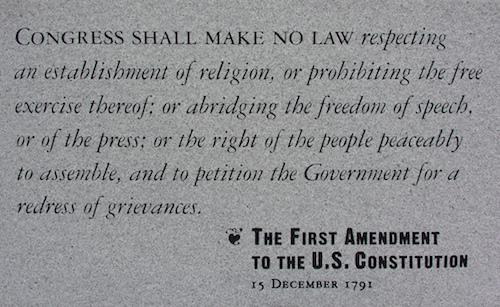Free to Associate, Not Forced to Associate

By Abby Streu
The very first amendment to the United States Constitution gives Americans the right to assemble.
There’s no appendage to this amendment declaring that that right turns into a requirement, depending on one’s field of labor or location.
But in certain regions of the United States, workers can be required to associate with a union as a condition of employment, regardless of their own desires for workplace negotiation.
And with this forced association comes forced financial obligations in the form of union dues.
Union leaders say that workers who leave the union and cease to pay union fees and dues are riding on the coattails of collective bargaining representatives, reaping the spoils the union fought so hard to gain for workers. This is the so-called “free-rider” argument.
The International Union of Journeymen and Allied Trades, for example, detail on their website that “some workers may now become free riders, refusing to help pay the expenses that the union incurs while protecting their rights and the rights of all employees, but still reap all of the benefits.”
But this logic is backwards. Wouldn’t it be cost effective to merely stop negotiating for the people who don’t want union representation?
And they can if they so choose. In the case Consolidated Edison Co. v. National Labor Relations Board, 305 U.S. 197 (1938), the Supreme Court found that labor unions are able to negotiate on behalf of their members only.
This case was affirmed around a quarter century later in Retail Clerks v. Dry Lion Goods, 369 U.S. 17 (1962), as the courts again found that labor unions can indeed negotiate only for their members.
The National Labor Relations Act protects the right of workers to choose union representation. This does not mean workers should be forced to be part of a union. The NLRA outlines a right, but labor unions have warped that right to become a requirement.
In the case Communication Workers v. Beck, 487 U.S. 735 (1988), the Supreme Court found that non-members of a union cannot be forced to pay the full union dues. However, if their employer and the union have created a contract that states that the union represents all members, that non-member must pay the agency fee that cost the firm to negotiate for that bargaining unit.
The NLRA, which allowed for unions to grow into these gang-like organizations, has been challenged on its constitutionality, but to no avail. In NLRB v. Jones & Laughlin Steel Corp., 301 U.S. 1 (1937). Jones & Laughlin argued that the NLRA was unconstitutional, but the Supreme Court held that it was, in a vote of 5 to 4.
And so, the labor unions continue their scheme to gain more members by ensnaring workers in eternal representation. They contort the Constitution in an attempt to get what they want—more members means more collected dues means more income for the union bigwigs.
According to The Washington Free Beacon, Richard Trumka of the American Federation of Labor and Congress of Industrial Organizations (AFL-CIO) racked up a gross income of $293,750 in 2011. And Media Trackers reported that in 2013, Joseph Senese of the National Production Workers Union earned $698,406.
Our Founding Fathers didn’t intend for the Constitution to say “We give you these individual rights for the sole purpose of organized labor associations to exploit for their financial gain.”
If they had meant that, I’m sure they would have added a footnote.





